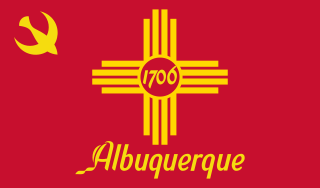
The state flag of Alaska displays eight gold stars, forming the Big Dipper and Polaris, on a dark blue field. The Big Dipper is an asterism in the constellation Ursa Major, which symbolizes a bear, indigenous to Alaska. As depicted on the flag, its stars can be used as a guide by the novice to locate Polaris and determine true north.

The flag of Singapore was adopted in 1959, the year Singapore became self-governing within the British Empire. It remained the national flag upon the country's independence from Malaysia on 9 August 1965. The design is a horizontal bicolour of red above white, overlaid in the canton by a white crescent moon facing a pentagon of five small white five-pointed stars. The elements of the flag denote a young nation on the ascendant, universal brotherhood and equality, and national ideals.

The Bear Flag is the official flag of the U.S. state of California. The precursor of the flag was first flown during the 1846 Bear Flag Revolt and was also known as the Bear Flag. A predecessor, called the Lone Star Flag, was used in an 1836 independence movement; the red star element from that flag appears in the Bear Flag of today.

The flags of the U.S. states, territories, and the District of Columbia exhibit a variety of regional influences and local histories, as well as different styles and design principles. Modern U.S. state flags date from the turn of the 20th century, when states considered distinctive symbols for the 1893 World's Columbian Exposition in Chicago, Illinois. Most U.S. state flags were designed and adopted between 1893 and World War I.

A solar symbol is a symbol representing the Sun. Common solar symbols include circles, crosses, and spirals. In religious iconography, personifications of the Sun or solar attributes are often indicated by means of a halo or a radiate crown.

The flag of Arizona consists of 13 rays of red and weld-yellow on the top half. The red and yellow symbolize the Spanish conquistadores that explored this part of America; this is because the flag is inspired by the current flag of Spain. The center star signifies copper production; Arizona produces more copper than any other state in the US.

The current flag of Indiana was designed by Paul Hadley and officially adopted by the State of Indiana in May 1917.

The flag of Oklahoma, also known as the Oklahoma flag, is a rectangular field of sky blue on which is placed an Osage war shield with six crosses and seven pendant eagle feathers above the word 'Oklahoma' in white. Superimposed onto the crosses of the war shield is a calumet and an olive branch.

The current flag of South Dakota was adopted in 1992 to represent the U.S. state of South Dakota. It consists of a field of sky blue charged with a version of the state seal in the center, surrounded by gold triangles representing the sun's rays, surrounded in turn by inscriptions in gold sans-serif capitals of "south dakota" on top and "the mount rushmore state" on the bottom. The sun represents the common weather in South Dakota.

The flag of Tennessee displays an emblem on a field of red, with a strip of blue bordered by white on the fly. The emblem in the middle consists of three stars on a blue circle also with a white border. The central emblem portion of the flag has been adopted as the state's unofficial logo, and appears in the logos of some Tennessee-based companies and sports teams. Examples include the First Horizon Bank and the Tennessee Titans.

A sun cross, solar cross, or wheel cross is a solar symbol consisting of an equilateral cross inside a circle.

The Blue Sky with a White Sun is the national emblem of the Republic of China that covers the period of history in Mainland China and Taiwan.
Stromberg v. California, 283 U.S. 359 (1931), was a landmark decision of the Supreme Court of the United States in which the Court held, 7–2, that a California statute banning red flags was unconstitutional because it violated the First and Fourteenth Amendments to the United States Constitution. In the case, Yetta Stromberg was convicted for displaying a red flag daily in the youth camp for children at which she worked, and was charged in accordance with California law. Chief Justice Charles Hughes wrote for the seven-justice majority that the California statute was unconstitutional, and therefore Stromberg's conviction could not stand.

Reacting to protests during the Vietnam War era, the United States 90th Congress enacted Public Law 90-381, later codified as 18 U.S.C. 700, et. seq., and better known as the Flag Protection Act of 1968. It was an expansion to nationwide applicability of a 1947 law previously restricted only to the District of Columbia.

Under the Geneva Conventions, the emblems of the International Red Cross and Red Crescent Movement are to be worn by all medical and humanitarian personnel and also displayed on their vehicles and buildings while they are in an active warzone, and all military forces operating in an active warzone must not attack entities displaying these emblems. The International Red Cross and Red Crescent Movement recognizes four protection emblems, three of which are in use: the Red Cross, the Red Crescent, the Red Lion and Sun, and the Red Crystal.

The Zia or Tsʾíiyʾamʾé are an indigenous nation centered at Zia Pueblo (Tsi'ya), a Native American reservation in the U.S. state of New Mexico. The Zia are known for their pottery and use of the sun symbol. They are one of the Keres Pueblo peoples and speak the Eastern Keres language.

The flag of Madison, Wisconsin, includes a sky blue background with a diagonal white stripe that goes from the bottom left corner to the top right which symbolizes Lake Mendota, Lake Monona and the isthmus between them. At the center of the flag is a black cross, which symbolizes the four lakes, as well as the cross shape of the Wisconsin State Capitol. The gold circle in the middle represents the Wisconsin State Capitol's dome.
New Mexico – Mi Lindo Nuevo México is a song written and composed by Pablo Mares, which was adopted as the official bilingual song of New Mexico in 1995.

Gun laws in New Mexico regulate the sale, possession, and use of firearms and ammunition in the state of New Mexico in the United States.

The flag of Albuquerque, New Mexico, is the official municipal flag of Albuquerque, New Mexico. The design is a red field with yellow elements.























